The 100-ton stretching machine is also called the deep drawing hydraulic press, which is divided into a four-column deep drawing hydraulic press and frame-type deep drawing hydraulic press from the fuselage structure; it can be also divided into single-action deep drawing hydraulic press and double-action deep drawing hydraulic machines. According to the different stretching workpieces, various forming methods such as hydraulic pad stretching, lower ejecting cylinder stretching, and die stretching are commonly used.
The 100-ton stretching machine is suitable for various stamping processes such as stretching, bending, forming, punching, blanking, and flanging of plates. It is used in the manufacture of various containers and large automobile covers, etc., and in the molding of non-metallic materials.
1. Equipped with oil cooling device and light curtain safety protection device;
2. Optional touchscreen display and PLC programmable control system;
3. Equipped with liquid filling device for quick approaching stroke.
The 100-ton stretching machine works as follows:
1. Jogging: Press the corresponding button to generate the corresponding action, and release it to stop the action.
2. Manual: Press the corresponding button to produce the corresponding action until the limit position.
3. Semi-automatic.
(1) Constant pressure control: the sliding beam descends rapidly → descends slowly → pressurizes to the upper limit of the electric contact pressure gauge, then delays holding pressure → relieves pressure → returns (stops afterward).
(2) Constant position control: the sliding beam descends rapidly → descends slowly → pressurizes. When the sliding beam touches the proximity switch, it sends a signal to start holding the pressure delay → unloading → return (stop after).
With the rapid development of the automobile industry, especially the continuous expansion of the scale of light truck production, the main structure of its chassis - longitudinal beam primary forming equipment demand is also expanding. The traditional production process is the use of dozens of drilling press drilling and then forming, and now most manufacturers have used beam CNC punch punching processing, and efficiency has been greatly improved.
The Shuntec hydraulic press system is mainly composed of Siemens S7-300 PLC, Siemens TP1200 touch screen, Germany NOVO displacement sensor, Rexroth proportional flow valve, Jining Taifeng hydraulic system, high proportion pump, and so on.
Set relevant parameters in the touch screen, according to the feedback signal of the displacement sensor, S7-300 PLC after operation and processing control hydraulic components and proportional pump action, achieve process control requirements.
In addition, a proportional flow valve is arranged on the pipeline of the lower chamber of the oil cylinder. When the slider moves from fast to slow, the control signal of the proportional flow valve is changed to realize the adjustment of the valve port, so as to realize the smooth transition of the speed of the slider from fast to slow without impact.


A servo-hydraulic press is the servo motor-driven hydraulic press integrated with the precision pressure and position transducer for closed-loop control. The servo-hydraulic press uses the servo motor to replace the ordinary transmission motor. The motion curve of the press slider can be set according to the process requirements. Also, the pressure, stroke, and speed are freely adjustable on HMI. Thus, the servo-hydraulic press is widely used for high-precision molding processes, and for difficult-to-form materials and parts with complex shapes. It greatly improves the processing accuracy and the yield of the products, at the same time, it is more energy saving.
Servo-hydraulic press machine benefits
Compared with traditional hydraulic presses, the benefits of servo-hydraulic presses are obvious in the following points:
1. Universality, flexibility, and high level of intelligence
Due to its servo function, the slider movement curve is no longer just a sine curve but could be adjusted according to the process requirements.
2. High accuracy
Due to the advanced linear position transducer and pressure transducer, the motion of the slider could be precisely controlled and monitored. The position control accuracy is high level, especially near the position of the bottom dead center, the accuracy of the slider position can be guaranteed within ±0.01mm. The pressure control accuracy could be ensured within 1%. In this way, each punch of the servo-hydraulic press is highly stable during the production process. With a servo-hydraulic press, we could maintain production consistency and prevent the generation of defective products.
3. High productivity
The servo-hydraulic press retains the advantages of the crank press, the productivity is much higher than the conventional hydraulic press. During a working cycle, there is no need to complete a 360-degree rotation for the servo motor, and only need to swing a certain angle to complete the punching cycle, which further shortens the cycle time. It minimizes unnecessary travel of the slider and greatly improves productivity.
Hydraulic press machines are widely used in the manufacturing industry, but hydraulic presses need maintenance throughout their serving life. Let me share with you the five main points for simple hydraulic press machine maintenance.
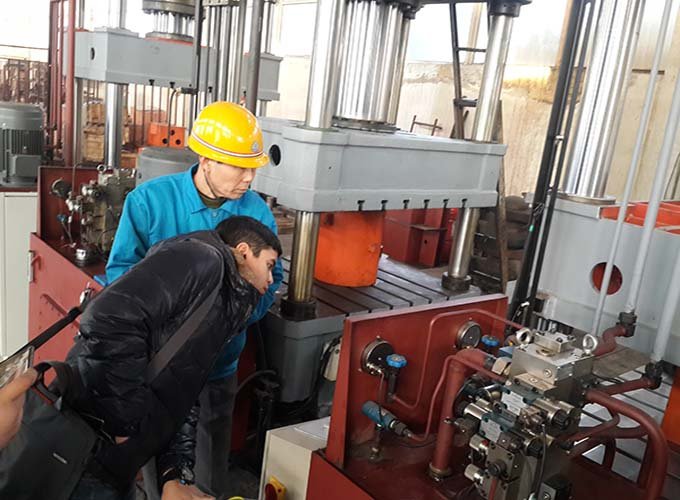
1. The oil liquid level of the oil tank should always be kept high enough to ensure that the oil in the system has sufficient circulating cooling conditions. Also, We should pay attention to keep the oil tank and oil pipes clean to facilitate heat dissipation. Generally, the safe operating temperature of the hydraulic press is 30℃-55℃, which is the most suitable temperature for use. With this temperature range, the hydraulic press machines could have the highest performance and the longest-serving life.
2. Hydraulic oil is the energy transfer medium when the hydraulic station is working. The quality, cleanliness, and viscosity of the hydraulic oil play a leading role throughout the serving life of the hydraulic pump, hydraulic valve, and hydraulic cylinder. Therefore, the quality of the hydraulic oil should be paid great attention to when using the hydraulic station. We should keep the hydraulic oil clean. The oil used in the hydraulic system must be strictly filtered, and the oil filter should be a must configuration in the hydraulic system.
3. The hydraulic oil must be replaced each year, and the first replacement time should not exceed three months; in order to ensure the reliable operation of the press, some components of the press are recommended to be replaced after the service life cycle is reached.
4. The sliding block should be filled with lubricating oil frequently, and the exposed surface of the columns should be kept clean and lubricated frequently. In order to prevent dust and water from falling into the oil, the area around the oil tank should be kept clean and regular cleaning should be carried out.
5. The working pressure output is adjustable by the pressure regulating valve. Under normal circumstances, the set pressure cannot exceed its original design rated pressure. Otherwise, it may cause damage to the hydraulic pump, hydraulic valves, and hydraulic cylinders.

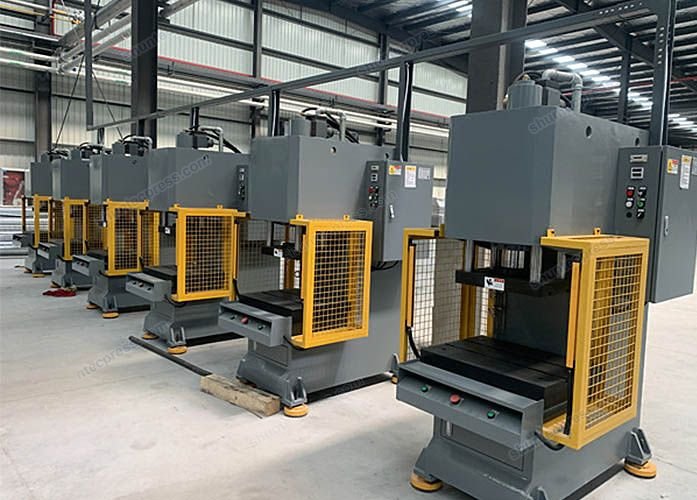
Definition
Hydroforming method refers to the use of liquid water, oil, or viscous material in replacement of a rigid concave mold or convex mold as the force transmission medium so that the material is shaped by fitting the convex mold or concave mold under the pressure of the force transmission medium. It is a kind of flexible forming technology.
Types Of Hydroforming
According To Different Liquid Media Used, Hydroforming Is Divided Into Pressurized-Water Forming And Pressurized-Oil Forming.
The medium used in pressurized-water forming is pure water or an emulsified liquid composed of water and a certain proportion of emulsified oil; the medium used in pressurized-oil forming is hydraulic transmission oil or engine oil.
According To Different Blanks Used, Hydroforming Is Divided Into Three Types: Tube Hydroforming, Sheet Hydroforming, And Shell Hydroforming.
Sheet and shell hydroforming uses lower forming pressure, whereas pipe hydroforming uses higher pressure, also known as internal high-pressure forming. The medium mostly used in sheet hydroforming is hydraulic oil, and the maximum forming pressure generally does not exceed 100MPa. The medium used in shell hydroforming is pure water, and the maximum forming pressure generally does not exceed 50MPa. The medium mostly used in pipe hydroforming/internal high-pressure forming is emulsified liquid, and the maximum forming pressure used in industrial production generally does not exceed 400MPa.
The Main Characteristics Of Modern Hydroforming Technology Which Began To Develop In The Mid-1980s Are Manifested In Two Aspects.
Firstly, since the liquid medium can be used as a convex mold or a concave mold, only a concave mold or a convex mold is needed respectively, so the mold costs and processing time can be saved by 50%. What’s more, the liquid used as a convex mold can form many complex parts that cannot be formed by a rigid convex mold. Secondly, liquid as a force transmission medium has real-time controllability, the pressure can be accurately controlled according to the given curve through the hydraulic closed-loop servo system and the computer control system, which ensures that the process parameters are within the set values, and are variable and adjustable over time, which greatly improves the process flexibility.
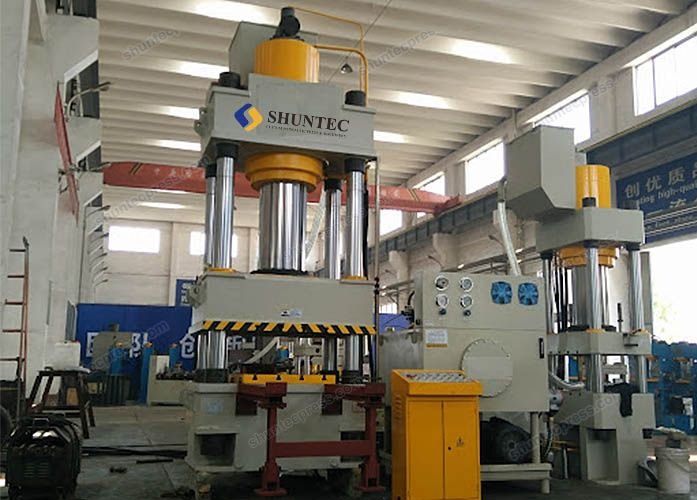

In order to make sure that you purchase the right 300-ton four-column hydraulic press which can reach your expectation of performance and effectiveness and which can be brought into full play in your routine manufacture, you should fully consider the following matters before you make your purchasing decision.
1. Understand The Characteristics Of Different Four-Column Hydraulic Press Manufacturers
At present, there are more and more manufacturers who can offer 300-ton four-column hydraulic presses. In order to exploit the machine’s advantages to the full in the production and processing industry, and make your specific needs satisfied, it is necessary that you understand the characteristics of different brands and confirm whether their prices are reasonable.
The four-column hydraulic press is a kind of equipment that uses an oil pump to transport hydraulic oil for processing operations. It is applicable to the processing of metals, plastics, and rubber, etc., and the effect is fairly good. Some of the advantages of a four-column hydraulic press are as follows:
First of all, it saves costs on mold use. Since a complete set of molds can satisfy the need for processing, costs on mold use can be reduced to a minimum.
Secondly, it can reduce the need for subsequent processing. Nowadays hydraulic presses have been developed to such a high level that they can not only fulfill their own routine duty but further complete the processing of the material as well. Therefore, manufacturers can be saved part of the subsequent processing and reduce production costs.
A four-column hydraulic press has a very stable performance. In actual application, it can reach high working efficiency and production accuracy.
2. Determine Your Specific Product Requirements And Processing Technology
Since the four-column hydraulic press has many specifications and models, before you choose your manufacturer and model, you should determine your specific needs of product function. Consider your own application environment so that the machine you choose can serve your purpose to the best. Choose the right model according to your requirement of production technology, so that the production can be more professional.
Shuntec is a custom 4-column hydraulic press machine manufacturer for years. We build every 4-column hydraulic press directly to your specifications and your unique application. Feel free to contact us when comes to a 4-column hydraulic press.
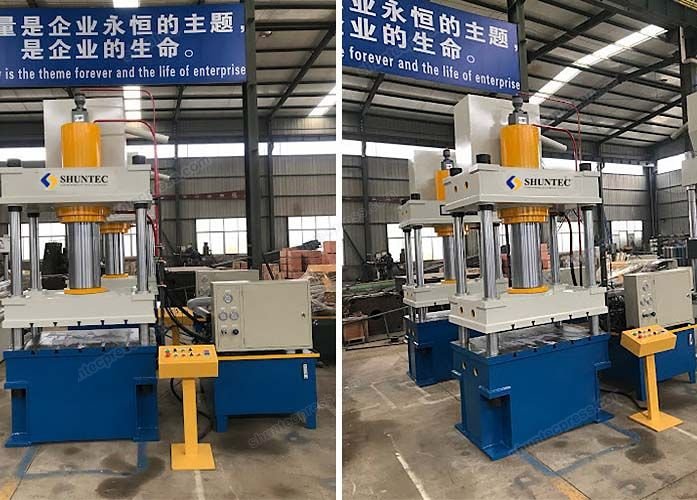

Use Purpose
Shuntec 200 ton four-column hydraulic press is a common machine model used in many industries. Usage includes forging, stamping, cold extrusion, straightening, die-cutting, aluminum sheet stretching, aluminum product die forming, and stainless steel product dies forming.
Structure
Shuntec 200-ton four-column hydraulic press is composed of an upper beam, a sliding block, a worktable, a four-post rod, the main cylinder, a hydraulic power system, and an electrical system. The upper beam, sliding block, and worktable are welded with high-quality steel plates, and the internal stress is eliminated by vibratory stress relief. The surfaces of all four columns are medium-frequency quenched and chrome-plated.
Features
1. Three-stage speed control of the movable beam: fast approaching speed, slow pressing speed, and fast return speed.
2, The main cylinder and the press cylinder have upper and lower limit protection, and the setting of the upper and lower limit positions is simple, convenient, and fast, either by the position limit switches or via HMI.
3. Safety protection methods to ensure safe operation.
4. Low energy consumption, high efficiency, novel styles.
Performance
1. The lower cylinder plunger is replaced with the structure of hard chromium-plated steel and wear-resistant ring to avoid the problem of plunger cracking.
2. The sealing ring of the lower cylinder adopts an imported combination ring, which can last for more than 15 years without replacement.
3. Columns and piston rods are all treated with intermediate-frequency heat treatment, and the surface is hard chrome-plated.
4. The material ejecting cylinder can be individually jog controlled.
5. The hydraulic system uses a cartridge valve. Cartridge valve has a large passage which has the advantages of large flow, high speed, low noise, and low heat.
6. Electrical control is realized by a single-chip microcomputer. The advantage of this system is that it has a safe control voltage of 24V. There is no intermediate relay.
6. The whole computer chip has high stability, long service life, and simple operation.
7. A wide range of grating safety protection devices.
Feel free to contact us for more details about the Shuntec 200 ton four-column hydraulic press.
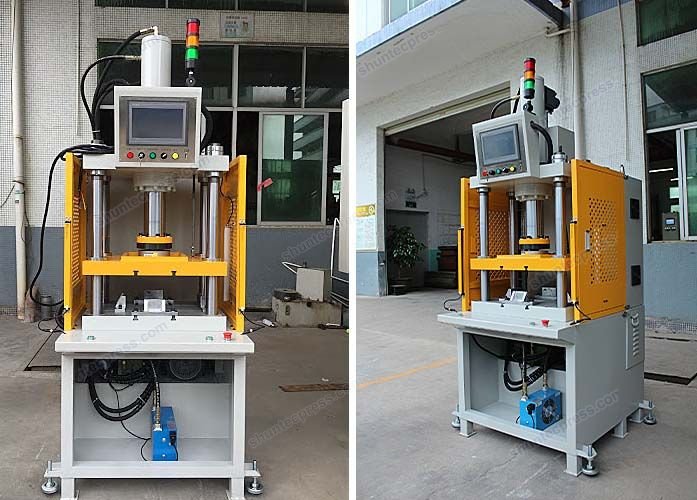
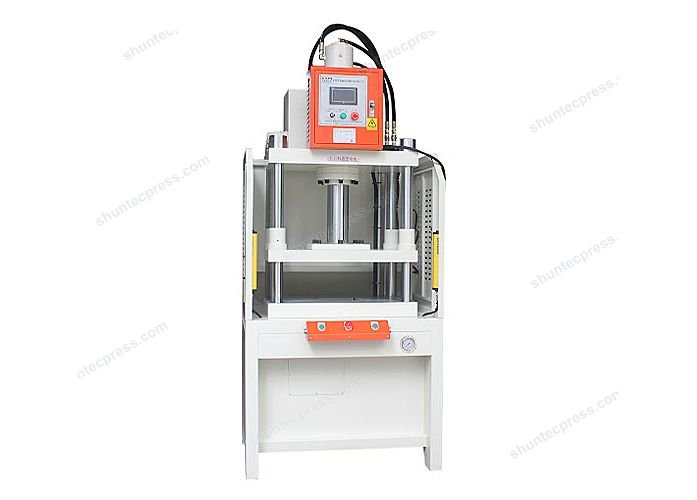
When The Servo-hydraulic Press Machine Is Working, If The Oil Temperature Rises Too Fast, It Will Cause A Series Of Adverse Effects For The Hydraulic System.
The temperature-rising and heating of the hydraulic system is a kind of comprehensive failure, just like pollution. It is mainly measured by testing the oil temperature and some hydraulic components. Temperature-rise will seriously affect the operation of the hydraulic system in the following ways.
1. It will increase the leakage of the servo-hydraulic press machine, and the volumetric efficiency of the pump and the whole system will be significantly reduced.
2. It will cause thermal deformation of the machine, which not only makes the gap between the moving parts with different thermal expansion coefficients in the hydraulic components become smaller and thus causes the parts to get jammed and causes malfunction, but affects the accuracy of the hydraulic equipment as well, resulting in poor parts processing quality.
3. It will also deform the rubber seals of the servo-hydraulic machine, causing premature aging and failure and reducing the service life.
It will not only invalidate the rubber seals but cause leakage as well, which will, in turn, cause further heat generation and temperature rise.
4. If the oil temperature of the servo-hydraulic press is too high, it will accelerate the process of oxidative deterioration of the oil, under which condition the pitch will be released, the service time of the hydraulic oil will be reduced.
5. As the oil temperature of the servo-hydraulic machine rises, the air separation pressure decreases, and the dissolved air escapes from the pump, resulting in cavitation, which lowers the working performance of the hydraulic system.
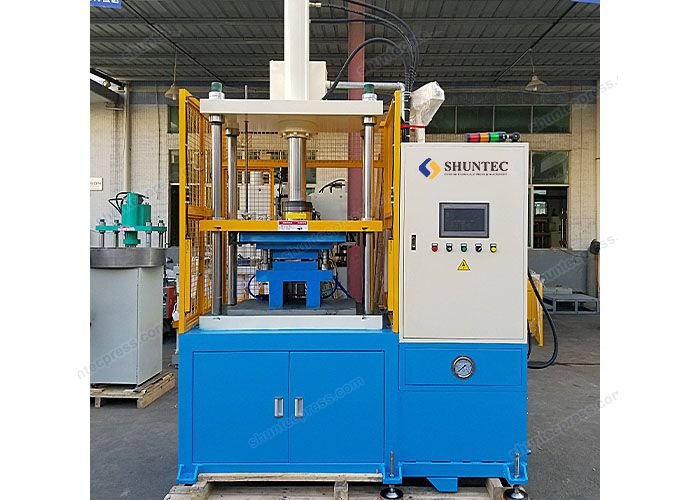

1. Structure
1) The machine body of the servo-hydraulic press can be designed in any of the traditional frame structures such as 2-post, 4-post, benchtop, c frame, etc., which are simple and compact and only takes up small area.
2) The common type of the main cylinder is a piston-type oil cylinder with a fast cylinder inside, which can achieve high-speed downward movement and slow-speed pressing of the down-acting stroke. The double-start operation is safe and very convenient.
3) Any location through the whole journey can be positioned by an electronic ruler. High-precision positioning adopts a mechanical dead limit, and the theoretical positioning accuracy is ±0.01mm, whereas the actual positioning accuracy ranges from 0.01-0.02mm.
4) The electrical system adopts the mode of PLC + servo
System + touch screen + proportional drive, and in collaboration with the proportional hydraulic system, it gives instructions according to specific process requirements to complete cycles of actions.
5) Multiple groups of parameter programs can be accessed freely from the friendly human-machine interface.
6) Pressure is detected by a pressure sensor, and the machine pressure can be set according to actual needs.
7) The servo-hydraulic press machine is optional with a shuttle worktable, which can move in and out of the working area automatically for automatic feeding.
8) The pressing speed is fast, and the pressing cycle of a single product takes only 4-5 seconds.
2. Application
1) The servo-hydraulic press can be used for pressing operations in such areas as motor, auto parts, home appliances, and electronics industries.
2) Used in constant pressure system.
3) Used in compression and extension test system.
4) Embossing, forming, shallow drawing, shaping, and pressure fit of metal or non-metal parts. Pressing of glasses and hardware products.
5) The wide range of applicable products includes watch cases, glasses, mobile phone products, tableware, signs, jewelry, parts, etc.
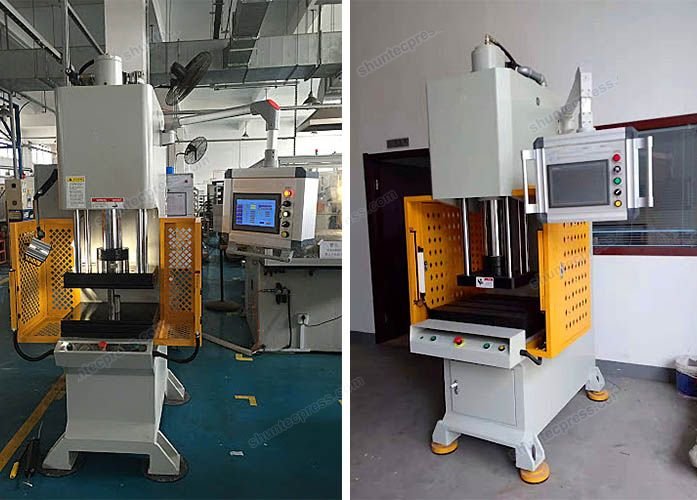
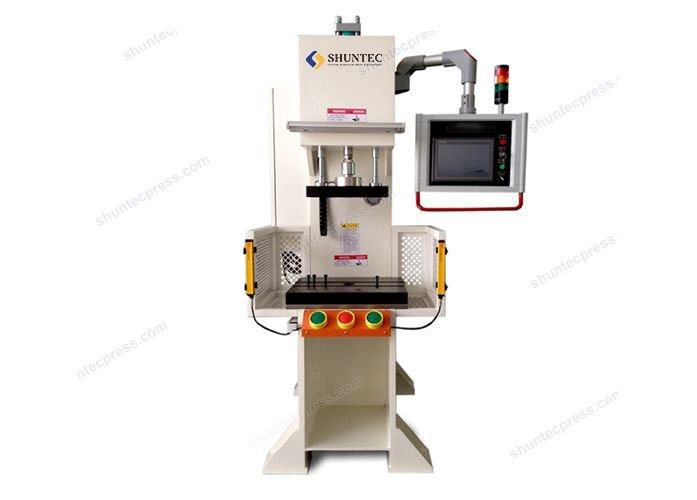
Servo press machine, as a new technology, has advantages that traditional hydraulic presses do not have. In automotive manufacturing processes, such as cylinder head valve seat ring and pipe press fitting, cylinder waterway blanking cap press fitting, transmission bearing press fitting, wheel hub assembling, and others, the servo press machine is gradually taking place of traditional hydraulic presses and has significantly improved the level of the automobile manufacture process.
Analysis Of Advantages
1. High Efficiency And Energy Saving
There is no energy consumption caused by clutch friction and flywheel idling. What’s more, the motor itself is of high efficiency, which makes the servo press machine highly efficient and energy-saving.
2. Intelligent Automatic Numerical Control
The operation of the press is controlled by a high-speed computer intelligent numerical control system, which can be fully automated without resorting to manual operation.
3. Long Service Time Of Mold
The pressure is numerically controlled, so the mold will not be overloaded, worn, or damaged.
4. The Products Are Precisely Formed, With Small Tolerances And High Precision
The pressure is under stable numerical control, and the mold wear is reduced to a minimum. The products are precisely formed under precise numerical control. The forge pieces have no/few trimmings, tolerance is small, and precision is high. No/few cutting is needed. Subsequent processes such as milling and digging are also not needed. With such capability, stud gear and bevel gear can be directly shaped and produced.
5. High Reliability
The servo press has no quick-wear parts, the motor rotor has neither windings nor conductors and not to mention permanent magnets. It is stronger than permanent magnet servo motors, sturdy, reliable, and shock-resistant. The equipment is maintenance-free and thus does not entail any maintenance personnel and working hours.
6. Intelligent Mold Adjustment
The machine body is equipped with a tonnage sensor, which can adjust and test the mold under pressure control. When the slow-speed mold adjustment and short-distance mold alignment are performed, the machine will not be caused to stop. And for mold adjustment and trial, no special equipment and personnel are needed, which saves human resources and working hours.
7. Information Management
The process parameters are numerically controlled in real-time and feedback is given by the communication network in real-time, which realizes the information control of product quality and the traceability of product quality.
8. Resource-saving And Environment-friendly
No permanent magnet rare earth materials are needed, which saves rare and valuable resources and avoids damage to the environment caused by the mining of rare-earth.
9. The Human-machine Interface Has Good Interaction
The motor is numerically controlled. In this way, the user can only input simple displacement and speed parameters to realize the numerical control of an intelligent flexible process curve. The users do not need to compile the process curve by themselves, which shows the great convenience of the machine.
10. The Structure Of The Equipment Motor-deceleration Mechanism-brake-working Unit Is Extremely Simple And Concise, And The Cost Is Low.
With the rapid development of modern industry, the automated production equipment for servo presses is gradually developing towards intelligence, flexibility, energy-saving, high precision, high quality, and high safety.

